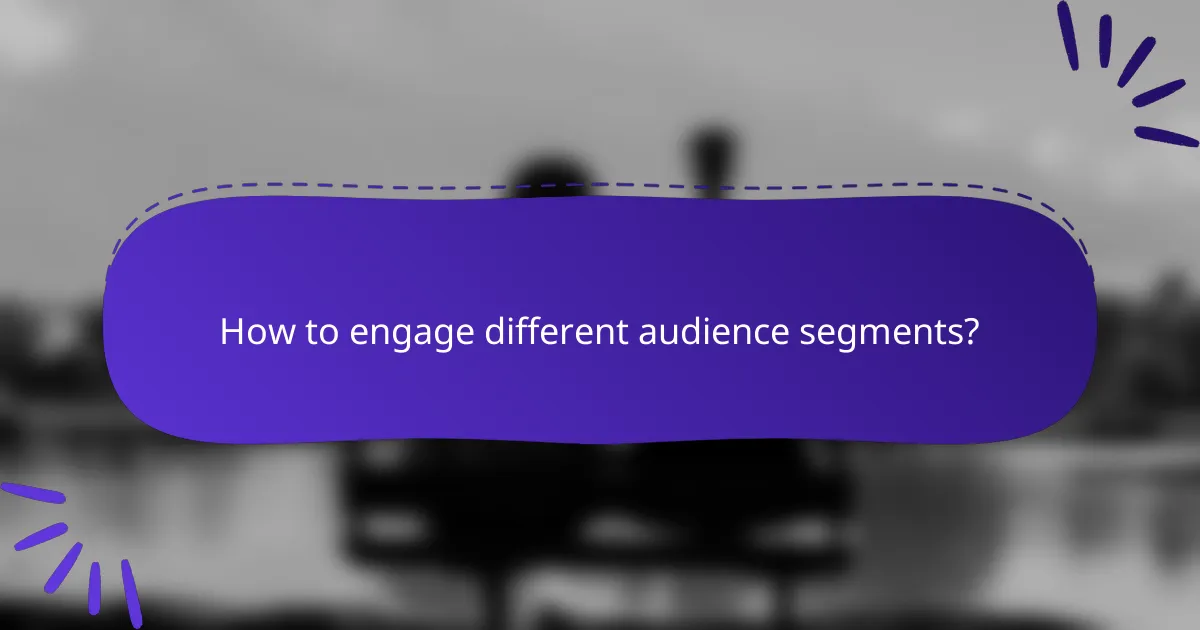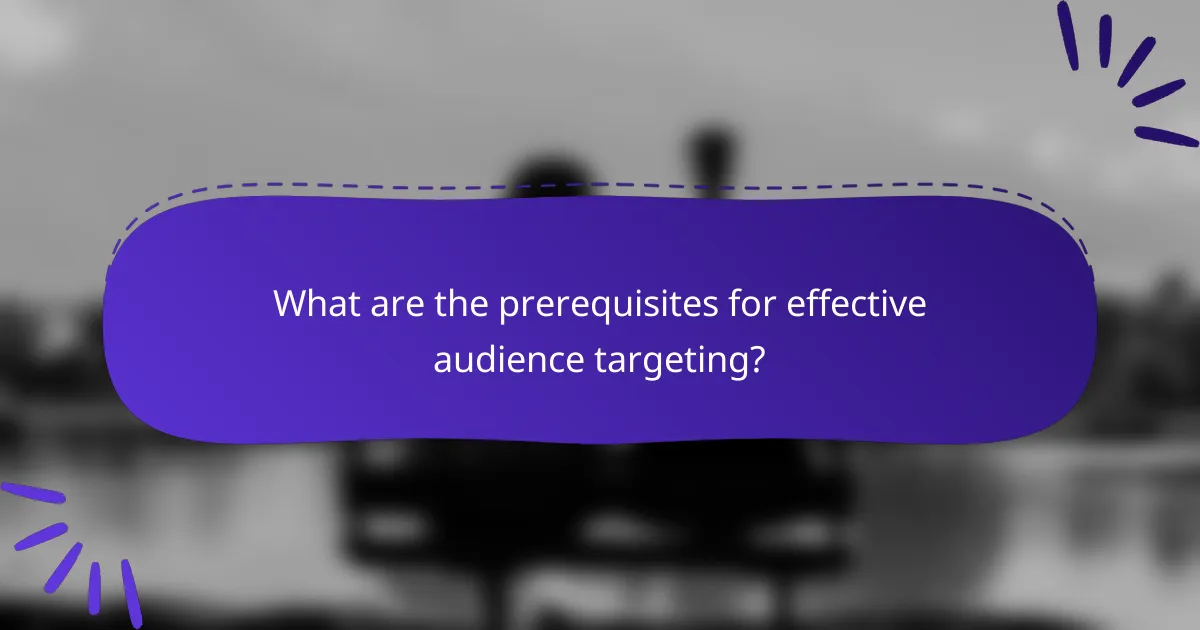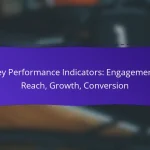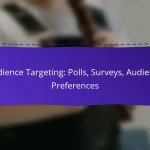Audience targeting is a crucial strategy for businesses aiming to optimize their marketing efforts and drive e-commerce sales. By segmenting the market based on demographics and shared characteristics, companies can create tailored campaigns that resonate with specific customer groups, ultimately enhancing engagement and increasing conversion rates.

How can audience targeting improve e-commerce sales?
Audience targeting enhances e-commerce sales by allowing businesses to tailor their marketing efforts to specific customer segments. This focused approach increases the likelihood of conversions, fosters loyalty, and maximizes the effectiveness of advertising spend.
Increased conversion rates
Targeting the right audience leads to higher conversion rates by ensuring that marketing messages resonate with potential buyers. By analyzing demographics and behaviors, businesses can create personalized campaigns that address the specific needs and preferences of their audience.
For example, a clothing retailer might target ads for winter apparel to customers in colder regions, resulting in a higher likelihood of purchase. Implementing A/B testing can further refine these efforts by identifying which messages and offers yield the best results.
Enhanced customer loyalty
Effective audience targeting fosters customer loyalty by creating a more personalized shopping experience. When customers feel understood and valued, they are more likely to return for repeat purchases.
Utilizing customer data to send tailored promotions or recommendations based on past purchases can significantly enhance engagement. For instance, a beauty brand might offer exclusive discounts on products similar to those a customer has previously bought, reinforcing their connection to the brand.
Higher return on ad spend
Audience targeting can significantly improve return on ad spend (ROAS) by ensuring that marketing budgets are allocated efficiently. By focusing on segments that are more likely to convert, businesses can reduce wasted ad spend on uninterested audiences.
For instance, a small business might find that targeting local customers through social media ads yields a higher ROAS compared to broader campaigns. Regularly analyzing performance metrics allows businesses to adjust their strategies and optimize spending for maximum impact.

What are effective audience segmentation techniques?
Effective audience segmentation techniques involve dividing a target market into distinct groups based on shared characteristics. This allows marketers to tailor their strategies to meet the specific needs and preferences of each segment, enhancing engagement and conversion rates.
Demographic segmentation
Demographic segmentation categorizes audiences based on quantifiable characteristics such as age, gender, income, education, and family size. For example, a luxury brand may target high-income individuals aged 30-50, while a children’s toy company focuses on parents aged 25-40.
When implementing demographic segmentation, consider the specific demographics relevant to your product or service. Use surveys and market research to gather data, ensuring your segments are based on accurate and current information.
Behavioral segmentation
Behavioral segmentation divides audiences based on their interactions with a brand, including purchasing behavior, product usage, and brand loyalty. For instance, a subscription service might target frequent users with special offers, while occasional users may receive re-engagement campaigns.
To effectively use behavioral segmentation, analyze customer data to identify patterns and preferences. This can help create personalized marketing strategies that resonate with different user behaviors, driving higher engagement and retention.
Geographic segmentation
Geographic segmentation focuses on the location of the audience, such as country, region, city, or even climate. Businesses can tailor their offerings based on local preferences; for example, winter apparel brands may target colder regions with specific marketing campaigns.
When applying geographic segmentation, consider local customs, language, and economic conditions. Utilize location-based data to refine your marketing strategies, ensuring they align with the unique characteristics of each geographic segment.

What insights can be gained from audience demographics?
Audience demographics provide valuable insights into the characteristics of a target market, helping businesses tailor their marketing strategies effectively. By understanding factors such as age, gender, income, and education, companies can create more relevant content and improve engagement with their audience.
Age and gender trends
Age and gender trends reveal how different segments of the population respond to products and marketing campaigns. For instance, younger audiences may prefer digital platforms, while older demographics might engage more with traditional media. Understanding these preferences can guide content creation and advertising strategies.
Gender also plays a crucial role in purchasing behavior. For example, certain products may appeal more to one gender, influencing how marketing messages are crafted. Analyzing these trends can help businesses optimize their outreach efforts.
Income level impacts
Income levels significantly affect consumer behavior and purchasing power. Higher-income individuals may prioritize quality and brand reputation, while lower-income consumers often seek value and affordability. This understanding can help businesses position their products appropriately in the market.
For example, luxury brands typically target higher-income demographics, while discount retailers focus on budget-conscious shoppers. Tailoring marketing strategies to these income segments can enhance engagement and conversion rates.
Education and occupation correlations
Education and occupation are closely linked to consumer preferences and behaviors. Higher education levels often correlate with increased awareness of product quality and sustainability, influencing purchasing decisions. Understanding these correlations can help businesses align their messaging with the values of their target audience.
Moreover, specific occupations may dictate the types of products or services that appeal to individuals. For instance, professionals in tech fields may prioritize innovative gadgets, while those in education might value resources that support learning. Recognizing these nuances can improve targeting and engagement strategies.

How to engage different audience segments?
Engaging different audience segments requires tailored approaches that resonate with each group’s unique preferences and behaviors. By understanding the characteristics of each segment, marketers can implement strategies that effectively capture attention and drive interaction.
Personalized marketing campaigns
Personalized marketing campaigns focus on delivering relevant content to specific audience segments based on their interests and behaviors. This can involve using data analytics to identify customer preferences and tailoring messages accordingly.
For example, a retailer might send personalized product recommendations based on past purchases, increasing the likelihood of conversion. Utilizing customer names in communications and addressing their specific needs can significantly enhance engagement rates.
Targeted social media strategies
Targeted social media strategies involve creating content that speaks directly to the interests of different audience segments on platforms like Facebook, Instagram, and LinkedIn. Each platform has unique demographics, so understanding where your audience spends their time is crucial.
For instance, younger audiences may be more active on Instagram, while professionals might prefer LinkedIn. Tailoring content formats—such as videos for Instagram and articles for LinkedIn—can improve engagement and shareability.
Email marketing segmentation
Email marketing segmentation allows businesses to divide their email lists into smaller groups based on specific criteria, such as demographics, purchase history, or engagement levels. This enables marketers to send targeted messages that are more likely to resonate with each segment.
For example, a company might segment its list into new customers and repeat buyers, sending tailored offers that encourage repeat purchases for the latter. Regularly updating and refining segments based on engagement metrics can optimize campaign performance and reduce unsubscribe rates.

What tools can assist in audience targeting?
Several tools can enhance audience targeting by providing insights into user behavior, demographics, and preferences. Utilizing these tools can help marketers tailor their strategies to engage specific segments effectively.
Google Analytics
Google Analytics is a powerful tool that tracks and reports website traffic, helping businesses understand their audience’s behavior. It provides insights into user demographics, interests, and geographic locations, allowing marketers to create targeted campaigns based on real data.
To maximize its effectiveness, set up goals and conversion tracking to measure the success of your audience targeting efforts. Regularly review the Audience Reports to identify trends and adjust your strategies accordingly.
Facebook Audience Insights
Facebook Audience Insights offers detailed information about your audience on the platform, including age, gender, location, and interests. This tool helps businesses understand their target market better and refine their advertising strategies based on user engagement.
When using Facebook Audience Insights, consider creating custom audiences based on specific criteria to enhance targeting accuracy. Regularly analyze the data to identify potential new segments and adjust your content to resonate with these groups.
HubSpot Marketing Hub
HubSpot Marketing Hub provides a comprehensive suite of tools for audience targeting, including email marketing, social media management, and content creation. Its analytics features allow businesses to track engagement metrics and segment their audience effectively.
Utilize HubSpot’s lead scoring system to prioritize high-value prospects and tailor your messaging accordingly. Regularly review your campaign performance metrics to optimize your audience targeting strategies and improve overall engagement rates.

What are the prerequisites for effective audience targeting?
Effective audience targeting requires a clear understanding of your target demographics, their behaviors, and preferences. It also involves utilizing appropriate data collection methods to gather insights that inform your strategies.
Data collection methods
Data collection methods are essential for gathering the information needed to understand your audience. Common techniques include surveys, interviews, web analytics, and social media monitoring. Each method offers unique insights and can be tailored to specific audience segments.
Surveys can provide direct feedback from your audience, while web analytics can reveal user behavior on your website. Social media monitoring allows you to track conversations and trends that resonate with your target demographic. Combining these methods often yields the most comprehensive understanding.
When implementing data collection, consider privacy regulations such as GDPR or CCPA that may affect how you gather and use data. Always ensure you have consent and provide transparency about how the data will be used to maintain trust with your audience.


